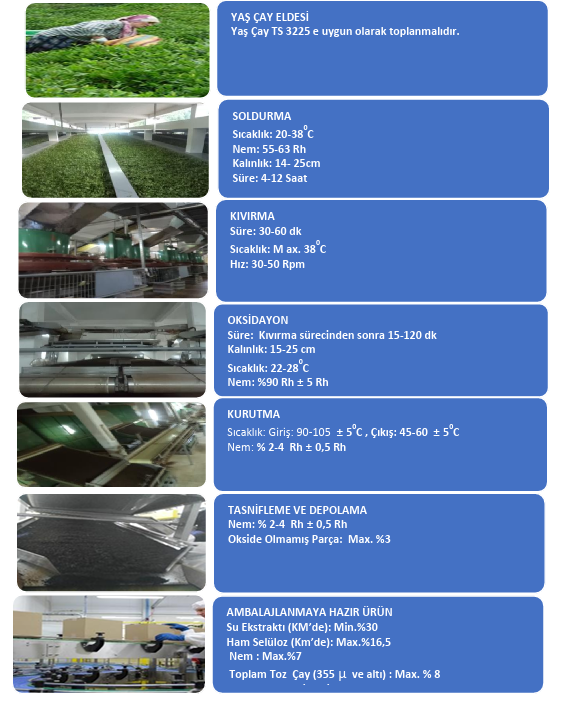Rize tea is a registered black tea type originating from Türkiye, obtained by cultivating and processing the tea plant belonging to the Camellia sinensis species within the borders of Rize province. Its geographical indication registration was made on March 26, 2021; the product registered as a designation of origin is included in the "processed and unprocessed fruits and vegetables and mushrooms" product group. The registration application was made by the Rize Commodity Exchange on August 15, 2017.

Rize Tea (Generated by Artificial Intelligence)
Geographical Boundary and Usage Conditions
Rize tea can only be produced from tea leaves cultivated and processed within the borders of Rize province. The product itself or its packaging must bear the original logo and designation of origin emblem with the phrase "Rize Çayı". In cases where use on the packaging or product is not possible, the relevant logo and emblem must be visibly displayed within the business premises.
Botanical Characteristics and Growing Conditions
Rize Tea is obtained from the Camellia sinensis tea plant, belonging to the Theaceae family, cultivated in humid climates, and whose leaves and buds are used in beverage production. It belongs to the black tea class, and the biological structure of the plant grown in Rize, the region's specific climatic and geological conditions, the agricultural techniques applied, and the tea's processing method determine its chemical, physical, and sensory characteristics.
Rize province has a topography that rises up to 3937 meters from the sea, with a mountain structure parallel to the sea. It hosts an ecosystem covered with broad-leaved forests up to approximately 750 meters from the coast, mixed forests between 800–1400 meters, and coniferous forests after 1600 meters, as well as alpine meadows with glacial lakes after 2400 meters. This structure determines the biodiversity of the microclimatic environment where the tea grows and its effects on the tea plant.
Production Process
Rize tea is processed only as black tea. Although there are some technical differences in the processing facilities operating in Rize province, the basic processing steps applied are the same. The production process consists of the following steps: obtaining fresh tea leaves, withering, rolling, oxidation, drying, classification, blending, and packaging. The methods used are essentially an adaptation of the orthodox processing system to local conditions. The mastery of tea processing techniques by the human resources in the region is a decisive factor in the implementation of the process.
Obtaining Fresh Tea Leaves
Fresh tea leaves are collected in accordance with Turkish Standard TS 3225. The preferred part consists of the bud at the tip of the tea shoot and the fresh first and second leaves immediately below it. This fiber-free two-and-a-half-leaf part is harvested by hand, with scissors, or with tea harvesting machines.
Withering
At this stage, the moisture in fresh tea leaves is reduced with the aid of hot air. Through the withering process, the leaves are brought to a physical structure suitable for the rolling stage. The temperature and duration applied vary depending on the tea's wetness, leaf freshness, environmental weather conditions, and production environment.
Rolling
Once the withering process is complete, the leaves are rolled by crushing, bending, and breaking them in various machines. During this process, the cell sap of the leaf comes to the surface. This allows the oxidation process to begin.
Oxidation
In rolled fresh tea leaves, chemical compounds found in the cell sap react under the effect of the polyphenol oxidase enzyme. As a result of this biochemical process, the desired color, astringency, brightness, aroma, and scent of black tea are formed.
Drying
This process stops oxidation and aims to preserve the qualities obtained. At the same time, the product is made suitable for storage and transport. Along with the drying process, the physical durability of the tea is increased.
Classification
Dried teas are separated according to criteria such as fineness, thickness, and quality. Each class of tea is appropriately labeled and bagged.
Storage and Packaging
Classified teas are blended to meet specific physical, chemical, and sensory characteristics. The resulting final product is packaged and sent to the market for sale.

Rize Tea (Turkish Patent)
Physical and Chemical Properties
The chemical and physical properties of Rize Tea are limited to the following ranges.
Physical and Chemical Properties of Rize Tea | Values | |
Minimum | Maximum | |
Total dust tea amount (particle size ≤ 355 µ) (g/g) (%) | 8 | |
Unoxidized particles (g/g) (%) | 3 | |
Total ash (on dry matter) (g/g) (%) | 4 | 8 |
Water extract (on dry matter) (g/g) (%) | 30 | |
Crude cellulose (on dry matter) (g/g) (%) | 16.5 | |
Alkalinity of water-soluble ash (as KOH) (on dry matter) (g/g) (%) | 1 | 3 |
Ash insoluble in 10% HCl (on dry matter) (g/g) (%) | 1 | |
Caffeine (on dry matter) (g/g) (%) | 1.6 | |
Water-soluble ash (relative to total ash) (g/g) (%) | 45 | |
Moisture content (g/g) (%) | 3 | 7 |
*Foreign matter: Should not be present. *Foreign matter: Refers to any substance that is not tea in origin, such as plant and animal-derived substances, stones, plastics, etc., and artificial substances. | ||
Sensory Characteristics and Evaluation
Rize tea must score at least 70 points in sensory analysis. The evaluation criteria and score distribution are as follows:
- Dry tea appearance: Black or dark copper colored, free from fibers and stalks (10 points)
- Brew color: Dark red, bright; should not be dull, cloudy or sedimented (25 points)
- Astringency: Should have a tongue-puckering quality (15 points)
- Fullness: Full-bodied taste profile (15 points)
- Brew residue (pulp): Color consistent, bright, few green leaves (15 points)
- Aroma: Characteristic to tea (20 points)
Brew color and brightness are among the most characteristic sensory features of Rize tea. Among the product's aroma components, theaflavin (TF) affects astringency, brightness, and briskness; while thearubigin (TR) affects the color of the brew.
Inspection and Control Process
The production and quality control of Rize tea are carried out by an inspection authority comprising representatives from the Rize Commodity Exchange (under its presidency), Recep Tayyip Erdoğan University, Rize Provincial Directorate of Agriculture and Forestry, TMMOB Chamber of Agricultural Engineers, and the National Tea Council. Inspections are conducted at least twice a year, and extraordinarily if necessary, upon complaint. The inspection covers the stages of tea plantations, production centers, storage areas, and packaging label control. Sample analyses are performed at the Rize Food Control Laboratory Directorate and other accredited laboratories.

